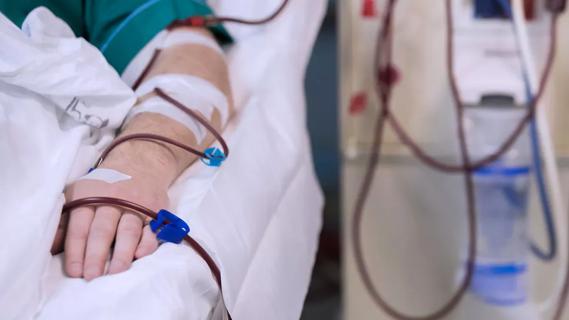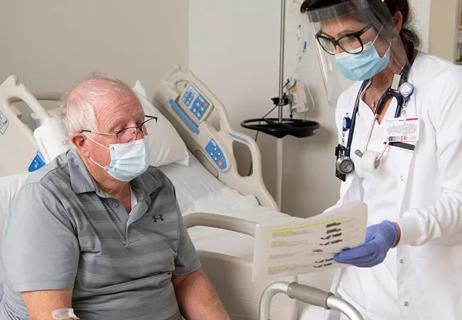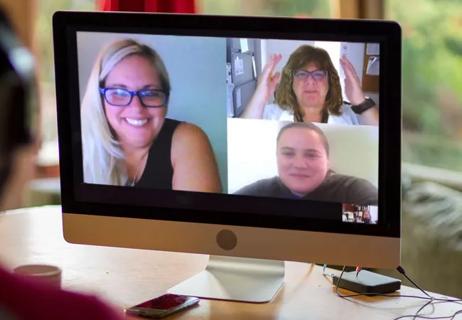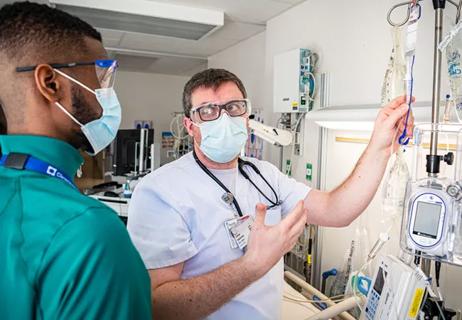Observing and assessing patients with greater accuracy

Cleveland Clinic strives to provide patients with excellent care and simultaneously, reduce the average length of stay and decrease readmission rates. Last year, nurses throughout the health system were instrumental in launching three tools that help meet those goals: a visual cueing system, an electronic discharge checklist and a vital sign alert system.
Cleveland Clinic is a non-profit academic medical center. Advertising on our site helps support our mission. We do not endorse non-Cleveland Clinic products or services. Policy
In September, Cleveland Clinic’s Fairview Hospital opened its rapid observation unit, which provides outpatient care to adult patients who are not ill enough to warrant inpatient hospital admission, but aren’t healthy enough to return home. Patients in the 25-bed unit receive expedited monitoring, diagnostic evaluation and treatment to quickly determine appropriate intervention and disposition. The targeted length of stay for the unit is under 18 hours.
One of the tools utilized by caregivers to achieve their length of stay goal is a color-coded visual cueing system on Epic, the hospital’s electronic medical record system (EMR). “Visual cueing allows us to readily and quickly see a list of our patients and how many hours they have been in observation status,” says Theresa Lattner, BSN, RN, CMSRN, nurse manager of the rapid observation unit. Patients’ names are highlighted in one of three colors indicating length of stay – green (up to 16 hours), yellow (16 to 18 hours) and red (over 18 hours).
“The visual cueing system facilitates conversation,” says Russ Ringwall, RN, assistant nurse manager on the unit. “If I see a patient in the yellow or red area, I wonder what’s holding us up. I can make a phone call or get the appropriate party involved, such as radiology, pharmacy, transport or care management.” A physician or nurse practitioner is on the unit at all times to expedite orders.
The rapid observation unit will soon add a second visual cueing component. Visilert devices will be mounted outside each patient room. When the transport team brings a patient to a room, they will hit a start button on the device, which tracks the amount of time the patient has been on the unit. Display screens on the devices will show a green, yellow or red light, corresponding with the color scheme in the EMR.
So far, visual cueing has been successful: The average length of stay in the unit has decreased from 22.4 hours when it opened to 19 hours. “We’re working in a synchronous, concise manner to ensure patients get the necessary care needed in an expeditious time frame, so that they can get home faster” says Lattner. “Visual cueing promotes costs savings to patients, as well.”
Rehospitalization rates for patients with heart failure continues to approach 30 percent within 60 to 90 days of hospital discharge, leading hospitals to seek innovative ways to decrease their readmission rate. “Our patients are the sickest of the sick, and keeping them out of the hospital is a huge feat,” says Josalyn Meyer, MSN, RN, NE-BC, nurse manager of the cardiac stepdown units at Cleveland Clinic’s main campus. “So we began some coordinated efforts around patient education.”
Several years ago, the health system launched a Heart Failure Survival Skills Class for patients. Many of the topics covered in the class, including nutrition management and medication information, formed the basis of a checklist used by nurses to ensure all pertinent information was provided to patients with heart failure prior to discharge. Created in 2013, the paper discharge checklist worked so well that it was embedded into Cleveland Clinic’s EMR system last year.
“The discharge process really starts upon admission,” says Meyer. “We know it’s important to have all caregivers collaborate with one another, and to speak with one voice so that patients and families understand self-care expectations. The heart failure discharge checklist helps.” It’s divided into five areas, listing all the tasks and patient education that must be completed by each area prior to discharge. It covers nutrition, nursing, pharmacy, care management and physician requirements.
When a patient is admitted, each area on the electronic checklist displays a red stop sign. “Nurses can mouse over the stop sign and see exactly what needs to be completed,” says Meyer. “When all components are done, the stop sign turns green and the caregiver will see a little check mark. Then, the physician can place the discharge order for the patient.”
Meyer says the checklist benefits nurses because it provides structure and keeps everybody focused on what the patient needs. “It helps our patients get the best possible care,” she says. “Nothing is left out inadvertently.” Data supports this claim: During the second quarter of 2014, we were above the national average for heart failure readmission rates on the cardiac stepdown, and with the process in place, we dropped by 5 percent.
That figure has improved most quarters since implementing the electronic checklist, nearing the goal of 20 percent by the fourth quarter of 2015.
In January 2015, Cleveland Clinic’s Medina Hospital began piloting a vital sign alert (VSA) system on its medical/surgical and cardiac stepdown units. “The system allows us to recognize subtle changes to patients’ vital signs, help nurses think through what might be impacting those vital signs and then determine what interventions we need to do to save or stabilize a patient,” says Kathy Burns, DNP, RN, ACNS-BC, ACCNS-A/G, CEN, a clinical nurse specialist at Medina Hospital.
The VSA system was developed by a multidisciplinary team of caregivers at the regional hospital in partnership with Cleveland Clinic’s Clinical Solutions Center in the Information Technology Department. The system, which displays on a pre-login screen and a customized report screen in the EMR, considers four parameters for each patient: systolic blood pressure, pulse, respiratory rate and oxygen saturation. It assigns points to each parameter – one point if it’s slightly out of range, two points if it’s significantly out of range. Based on the total score, the system indicates whether nurses should consider interventions to better stabilize the patient.
Each patient on the unit appears on a color-coded list at computer terminals at the nurses’ stations indicating that the vital signs are within range (green), are cause for awareness (blue), require a patient assessment (yellow) or necessitate immediate action (red). “We can sort and instantly know which patients on the units are the sickest ones,” says Dr. Burns. “If a patient’s status changes, everyone on the unit knows.” In addition, the VSA uses an intervention algorithm to provide care suggestions for nurses and pulls critical data to one report screen to support nurse critical thinking.”
Since implementing the VSA system more than a year ago, Medina Hospital has reported a 40 percent decrease in patient hours spent at higher acuity and a 52 percent reduction in time-to-reassessment of vital signs following an acute change. “We’re picking up signs that a patient might be deteriorating and intervening sooner,” says Dr. Burns. “Our nurses are working with physicians earlier to save lives or recognize that a patient needs a higher level of care.”
The system was rolled out at Cleveland Clinic’s Hillcrest Hospital in January under the name Vital Scout. It now includes a fifth parameter, oxygen supplementation, as a scoring component.

Phone triage system reduces call backs and delays in care

New protocol reduces costs, increases patient and caregiver satisfaction

New options benefit caregivers, nursing units and patients

Nurses facilitate preoperative program to educate and prepare patients for ongoing care

Introduces at-home work and new patient screening tool

Health disparities, mental health and more

Ideas for approaches to prevention, response and more

Educating and developing generations of nurses